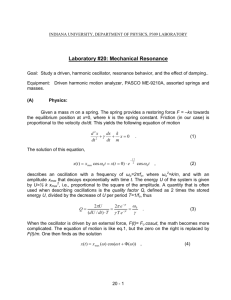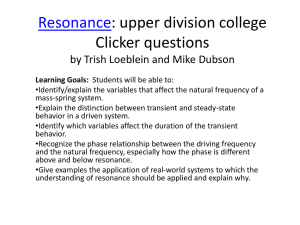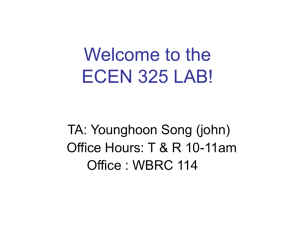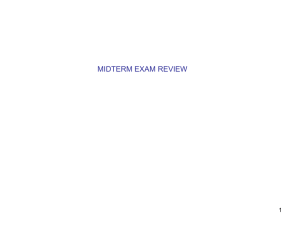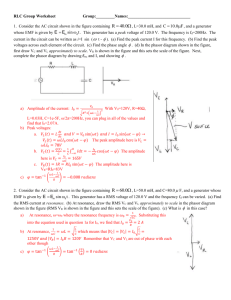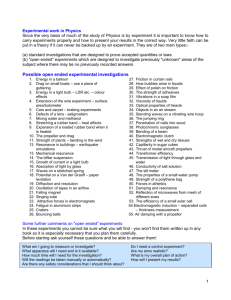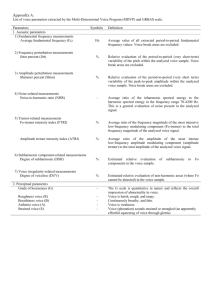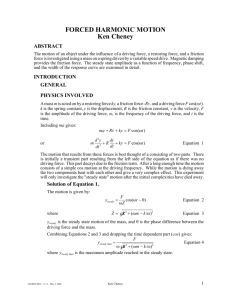4-1 Objective: • Study resonance in a simple mechanical system
advertisement
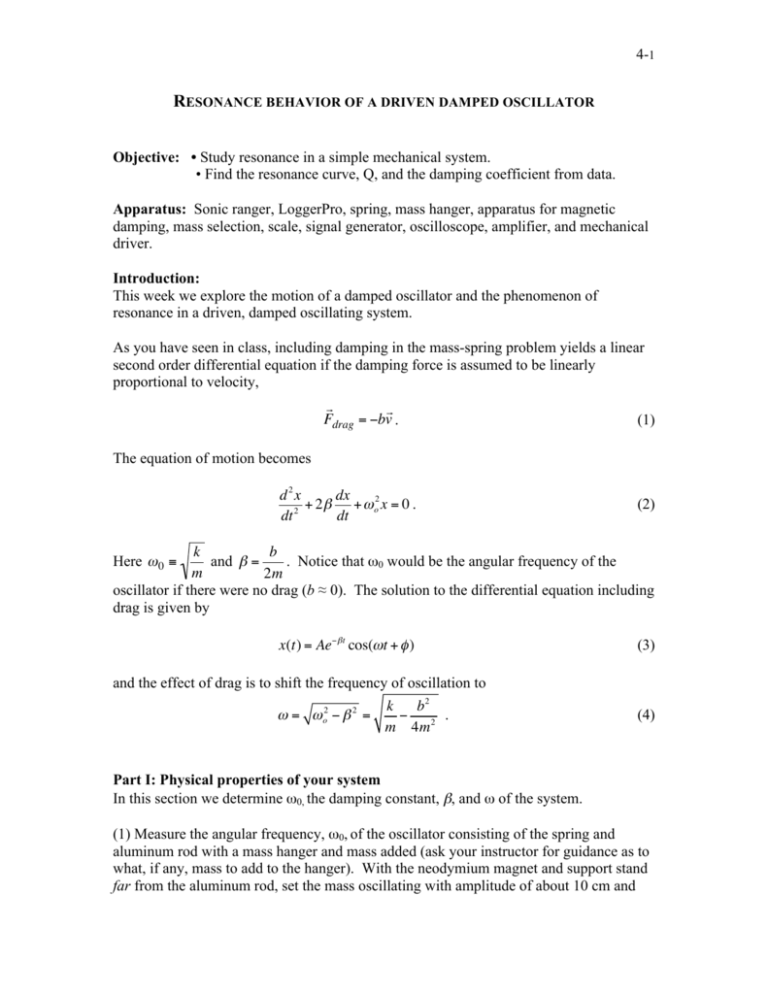
4-1 RESONANCE BEHAVIOR OF A DRIVEN DAMPED OSCILLATOR Objective: • Study resonance in a simple mechanical system. • Find the resonance curve, Q, and the damping coefficient from data. Apparatus: Sonic ranger, LoggerPro, spring, mass hanger, apparatus for magnetic damping, mass selection, scale, signal generator, oscilloscope, amplifier, and mechanical driver. Introduction: This week we explore the motion of a damped oscillator and the phenomenon of resonance in a driven, damped oscillating system. As you have seen in class, including damping in the mass-spring problem yields a linear second order differential equation if the damping force is assumed to be linearly proportional to velocity, ! ! Fdrag = "bv . (1) The equation of motion becomes ! d2x dx + 2 ! + " o2 x = 0 . 2 dt dt (2) b k and ! = . Notice that ω0 would be the angular frequency of the m 2m oscillator if there were no drag (b ≈ 0). The solution to the differential equation including drag is given by Here " 0 # ! x(t) = Ae! !t cos(" t + # ) (3) and the effect of drag is to shift the frequency of oscillation to ! = ! o2 ! " 2 = k b2 ! . m 4m 2 (4) Part I: Physical properties of your system In this section we determine ω0, the damping constant, β, and ω of the system. (1) Measure the angular frequency, ω0, of the oscillator consisting of the spring and aluminum rod with a mass hanger and mass added (ask your instructor for guidance as to what, if any, mass to add to the hanger). With the neodymium magnet and support stand far from the aluminum rod, set the mass oscillating with amplitude of about 10 cm and 4-2 record the motion with the sonic ranger for 10 s. Use the curve fit feature of LoggerPro to find a best fit for the sonic ranger data and record not only ω0, but its uncertainty as well. We will consider this arrangement to be a (relatively) “un-damped” oscillator. (2) Move the magnet and support stand so the magnet is 3 to 5 mm from the aluminum rod.1 When the oscillator is at rest, the magnet should be next to the middle of the aluminum rod. Now determine β and ω with their uncertainties. (3) Compare your measured value of ω to the prediction of equation (4). Is there a measurable difference between ω and the natural angular frequency ω0? Part II: Resonance When a driving force is added to this physical system, the equation of motion can be written as d2x dx F + 2 ! + " o2 x = o cos(" D t) . 2 dt dt m (5) We use a modified loudspeaker connected to a frequency generator to produce a driving force of the above form. Notice that ωD is the driving frequency; a parameter that we typically control. The late time or steady state solution to this differential equation is given by x p (t) = A cos(! D t ! " ) , (6) with Fo A= m (! ! ! ) + 4 " 2! D2 2 o 2 2 D , (7) and " 2 "# % ! = tan !1 $ 2 D 2 ' . # (# o ! # D ) & (8) This part of the lab focuses on equation (7), the relationship between the amplitude of steady-state oscillation and the driving frequency. In class and the reading you saw the effects of resonance, and the curves of amplitude A and total energy as a function of frequency. In this part of the lab you measure amplitude as a function of driving frequency, so you can create your own resonance curve for the mechanical system in front of you. Here’s how: 1 If the spacing to the magnetic damper is too large, damping will be so small as to make it difficult to obtain a resonance curve in Part II. Thus, the resonance will be very narrow and hard to scan given the resolution of the frequency generator. 4-3 (1) Calculate the resonant frequency with uncertainty. Turn on the frequency generator, power amplifier (switch is on the back), and the oscilloscope used to measure the frequency of the generator. The generator has two controls of interest for us: the amplitude and the driving frequency. The generator’s amplitude controls the amplitude of the mechanical driver. With the generator’s amplitude turned down, set its frequency to the value you calculated. Adjust the amplitude so that, at resonance, the neodymium magnet sweeps along about ¾ of the length of the aluminum rod. We want to insure that the magnet doesn’t collide with the spring or the mass hanger in the course of the oscillation when at resonance. (2) Measure the driving frequency on the oscilloscope and record it in a table of frequencies and amplitudes. (3) Set LoggerPro to record about 100 seconds of data. Start with the oscillator at rest, at its equilibrium position, and start recording data. Sit back and enjoy the show! Towards the end of the 100 seconds the system should settle down to oscillations with constant amplitude. Each time the frequency is changed you must wait until the system settles down—we say the “transient has died away”, before you take oscillator amplitude and frequency data for your table. (4) When you are convinced that the amplitude is remaining constant, set LoggerPro to take 10 seconds of data and find the amplitude with uncertainty of oscillation using Logger Pro to curve fit. You now have your first amplitude vs. frequency data point. (5) Explore the amplitude vs. frequency space by incrementing the frequency and repeating the above steps. In the end you should have about 10 points, centered on the resonance frequency, showing how amplitude depends on the driving frequency. Choose your frequencies appropriately. You must establish the range within which the ten points should fall. It is dependent on the damping and the damping is sensitively dependent on the magnet-rod spacing, different for each setup. Make sure the magnet-aluminum rod spacing doesn’t change between Part I and Part II. If it does change the comparison of these two methods of finding Q loses it significance. You may assume that the uncertainties for all your amplitudes and all your frequencies are the same. Make sure that you get data for the full resonance curve from low amplitude, to maximum amplitude, and back to low amplitude. Take more data if you need to fill in gaps in the curve. (6) Enter your data into Excel and plot the squared amplitude - proportional to average oscillator energy - versus driving frequency. (7) Add x and y error bars to your graph, as necessary. Print this plot and include it in your notebook. (8) Does your prediction for the resonant frequency agree with your results? Comment, noting whether you find agreement or not. If the latter, discuss what might have gone awry. 4-4 (9) The quality factor, Q, is a measure of the damping in terms of the natural angular frequency. It is approximately ! Q! 0 2" for light damping. Q in a resonant system describes mechanical amplification: the ratio of the resonance amplitude to the amplitude of the end of the spring vibrated by the driver is Q. The Q of a resonant system can also be found from the resonance curve you created in step (5) above: the higher the Q the sharper the curve. Your instructor can show you how to use LoggerPro to fit a resonance curve to your data, Amplitude 2 = B , (C ! f ) + DfD2 2 2 D where fD is the driving frequency, and B,C and D are fitting constants. The fitting procedure allow you to compute Q. You can use C (why?). Alternately using the D cursor on the resonance curve provided by the fit, estimate the width !f of the curve at one-half the maximum height. This will give you the “Q” of the mass-spring system with the relation f Q" R . #f This is an important way of characterizing resonant systems. Using uncertainties comment on this result for Q in comparison with what you obtained. Do they agree? !
